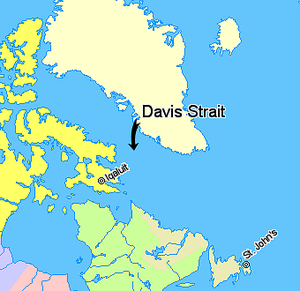Davis Strait

Davis Strait (Template:Lang-fr) is a northern arm of the Labrador Sea. It lies between mid-western Greenland and Nunavut, Canada's Baffin Island. The strait was named for the English explorer John Davis (1550–1605), who explored the area while seeking a Northwest Passage.
Geology
It is underlain by complex geological features of buried grabens (basins) and ridges, probably formed by strike-slip faulting during Paleogene times about 45 million to 62 million years ago. The strike-slip faulting transferred plate-tectonic motions in the Labrador Sea to Baffin Bay. It is the world's broadest strait.
Depth
With a water depth of between one and two thousand meters the strait is substantially shallower than the Labrador Sea to the south or Baffin Bay to the north.
Tides
The strait is famous for its fierce tides that can range from 30 to 60 ft (9.1 to 18.3 m), which discouraged many earlier explorers.[citation needed]
Further reading
- Boertmann, David. Mapping of Oil Spill Sensitive Areas in the Davis Strait, West Greenland A Review of Biological Data in Relation to Oil Spill Sensitivity Mapping, with an Identification of Data Gaps. Copenhagen, Denmark: Greenland Environmental Research Institute, 1992.
- Crawford, R. E. Life History of the Davis Strait Greenland Halibut, with Reference to the Cumberland Sound Fishery. Winnipeg: Dept. of Fisheries and Oceans, 1992.
- Dr̐ưue , C., and G. Heinemann . 2001. "Airborne Investigation Of Arctic Boundary-Layer Fronts Over The Marginal Ice Zone Of The Davis Strait". Boundary-Layer Meteorology. 101, no. 2: 261-292.
- Heide-Jorgensen, M P, H Stern, and K L Laidre. 2007. "Dynamics of the Sea Ice Edge in Davis Strait". Journal of Marine Systems : Journal of the European Association of Marine Sciences and Techniques. 67, no. 1: 170.
- Jones, A G E, and Arthur Credland. 1998. "The Greenland and Davis Strait Trade, 1740-1880". The Polar Record. 34, no. 189: 162.
- J̐ưrgensen, O, C Hvingel, P M̐ưller, and M Treble. 2005. "Identification and Mapping of Bottom Fish Assemblages in Davis Strait and Southern Baffin Bay". Canadian Journal of Fisheries and Aquatic Sciences. 62: 1833-1852.
- Mallory ML, GJ Roberston, and A Moenting. 2006. "Marine Plastic Debris in Northern Fulmars from Davis Strait, Nunavut, Canada". Marine Pollution Bulletin. 52, no. 7: 813-5.
- Ross, W. Gillies. Arctic Whalers, Icy Seas Narratives of the Davis Strait Whale Fishery. Toronto, Canada: Irwin Pub, 1985. ISBN 0772515247
External links
- June 2005 Satellite photograph of Davis Strait from MODIS, showing meltwater ponds.
67°00′38″N 058°01′44″W / 67.01056°N 58.02889°W
